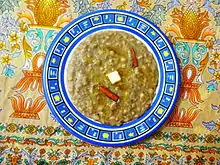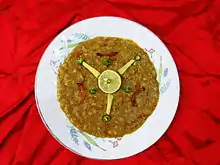Harees
Harees, jareesh (Arabic: هريس), boko boko, or harisa (Armenian: հարիսա, romanized: harisa) is a dish of boiled, cracked, or coarsely-ground cracked wheat or bulgur, mixed with meat and seasoned.[1] Its consistency varies between a porridge and a gruel. Harees is a popular dish known throughout the Arab world, and is commonly eaten in Arab states of the Persian Gulf in the month of Ramadan, and in Iraq, Lebanon and Bahrain during Ashura by Shia Muslims.
.jpg.webp) | |
| Alternative names | Jareesh, Hareesa, Haleem, Arizah |
|---|---|
| Type | Porridge |
| Place of origin | Oman and Yemen |
| Region or state | Middle East And Horn of Africa |
| Main ingredients | Wheat, butter, and meat (usually mutton), sometimes Chicken |
Etymology
"Harisa", also transliterated as "horisa", derived from the Semitic origins of "haras" meaning "to break" to describe the action of breaking and pounding the grains before mixing it with water to create a porridge.[2]
In Arabic, "Harees" (Arabic: هريس) is linked to the verb (Arabic: هَرَسَ, romanized: harasa) which still means to mash or to squash.[3]
According to Armenian lore, the patron saint of Armenia, Gregory the Illuminator, was offering a meal of love and charity to the poor. There weren't enough sheep to feed the crowds so wheat was added to the cooking pots. They noticed that the wheat was sticking to the bottom of the cauldrons. Saint Gregory advised, "Harekh! Stir it!" Thus, the name of the dish, harissa, came from the saint's own words. Harissa has been offered as a charity meal ever since.[4] The dish is traditionally served on Easter day. It is still prepared by many Armenians around the world and is also considered the national dish of Armenia.[4]
History
Harisa is mentioned by Ibn Al Karim in Kitab Al-Tabikh as early as the seventh century.[5] In the anecdotal cookbook, the Umayyad Caliph, Mu'awiya, returns from a trip to Arabia after returning to his newly won Persian lands. In some versions of the story, Mu'awiya is met with some Yemenite Jews whom he asks to prepare the porrige he tasted abroad while in other versions, he approaches locals. This story should be taken with a grain of salt as the author penned the story three centuries after it supposedly occurred. At the very least, harisa was prevalent as a Levantine dish.
Harees is documented in Ibn Sayyar al-Warraq's 10th-century cookbook Kitab Al Tabikh.,[6] as well as in al-Baghdadi's 13th-century cookbook Kitab Al Tabikh and ibn Razin al-Tujibi's 13th-century Andalusian cookbook Kitab Fadalat al-khiwan fi tayyibat al-ta'am w'al-alwan.
Preparation
The wheat is soaked overnight, then simmered in water along with meat and butter or sheep tail fat. Any remaining liquid is strained and the mixture is beaten and seasoned. Harees may be garnished with cinnamon, sugar, and clarified butter.
Variants and traditions
There is a different traditional way of preparing Harees in each of the Arab countries in the Arabian Peninsula area, and among the tribes of these countries. Some variations include the use of cardamom pods in Saudi Arabia, or a garnish with parsley.
Harees was only made by the wealthy during Ramadan and Eid, for the duration of a three- to seven-day wedding. It was, however, customary for the Harees dishes to be shared with poorer neighbours on such occasions.
It is similar to kashkeg, a kind of homogeneous porridge made of previously stewed and boned chicken or lamb and coarsely ground soaked wheat (typically shelled wheat).
Arab cuisine

Harees is a popular dish in Arab cuisine, from the Levant to the Persian Gulf. It is often served during Ramadan, festivals such as Eid ul-Fitr, and at weddings.[9] In Lebanon, it is often cooked on religious occasions in a communal pot, such as in Ashura. Harise is also a common dish in Syrian cuisine and Iraqi cuisine.
Formerly found only in homes, it is now served in restaurants as well.
Armenian cuisine


Harisa (Armenian: հարիսա, romanized: harisa) is traditionally served on Easter day, and is considered a national dish of Armenia.[4] It is a thick porridge made from korkot (dried or roasted cracked wheat) and fat-rich meat, usually chicken or lamb. Herbs were substituted for meat in harissa when Armenian religious days required fasting and penance. The extremely long cooking process is an essential part of the harisa tradition. Like other ritual dishes, the time taken for preparation is part of its cherished value.[4]
Harisa is known for helping the Armenians of Musa Ler (in modern-day Turkey) to survive during the resistance of 1915.[10]
Egyptian cuisines
In Egyptian cuisine, "freekeh", unripened, crushed durum wheat, was used to cook harisa, giving the resulting ferik a unique green hue.[11] The origin of the variation could be linked to the Sephardic migration of the 13th century, but historians remain uncertain.[12]
Kashmiri cuisine

Harisa or Hareesa (Kashmiri : ۂرؠ سہٕ [hərʲsɨ]) in Kashmir is prepared during winter (Chillai Kalan ),[13] typically made of mutton and rice flour and eaten with Kashmiri Bread called Girda (Kashmiri : گِردٕ [girdɨ] ). It is cooked in huge degs (earthen pots) placed in wood fired ovens. Downtown Srinagar is considered as the hub of harisa making in Kashmir.
Zanzibari
In Zanzibar, the dish is called boko boko and may be cooked with lamb, beef, or chicken.[14]
Ethiopia
Hareesa or Harees is a popular dish mainly in the Oromo region. It is cooked with lamb or beef and topped with dhadhaa/kibbeh and served on Eid or special occasions such as the birth of a baby.
See also
References
- "Al Harees, traditional Emirati Cuisine". UAE Style Magazine. 26 July 2013.
- Gil Marks, Encyclopedia of Jewish Foods, 656 (Hoboken, N.J.: John Wiley & Sons, 2010), 258.
- Team, Almaany. "Definition and meaning of Harees in Arabic - Arabic dictionary - Page 1". www.almaany.com.
- Irina Petrosian, David Underwood (2006). Armenian food: fact, fiction & folklore (2. ed.). Bloomington, Ind.: Yerkir Pub. p. 65. ISBN 9781411698659.
- Ibn al-Karīm, Muḥammad ibn al-Ḥasan, and Charles Perry. A Baghdad Cookery Book : the Book of Dishes, 127 (Kitāb Al-Ṭabīkh), (Totnes, UK: Prospect, 2005), 72.
- Charles Perry, "Cooking with the Caliphs", Saudi Aramco World 57:4 (July/August 2006) full text
- "The haleem debate: Why some Indian Muslims are renaming the Ramzan delicacy 'daleem'". 3 June 2019.
- Gil Marks, Encyclopedia of Jewish Foods, 656 (Hoboken, N.J.: John Wiley & Sons, 2010), 40.
- "Welcome to Abu Dhabi - Emirati Cuisine". Archived from the original on 2010-11-29. Retrieved 2010-11-07.
- Albala, Ken (2011). Food cultures of the world encyclopedia. Santa Barbara, California: Greenwood. p. 8. ISBN 9780313376276.
- Joel Haber, “Ferik-Egyptian Hamin”, (Jerusalem, Israel: Aish.com, 2022); Elais and Gary, “Lamb Harissa & Gazelle’s Horns”, (Santa Fe, NM:Made In Marrow, 2019).
- Marks, 11.
- Naqash, Rayan (16 December 2016). "It's harissa time again: Savour the traditional winter delicacy that warms up cold Kashmiri mornings". Scroll.in.
- Resta, Lizzie. "A Culture Seen Through Cuisine: Traditional Zanzibari Recipes." (2008). (PDF)